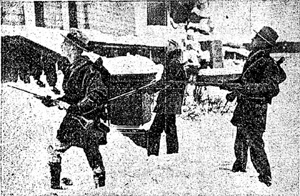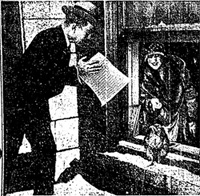The story of the Killer Hawk of Chicago is a classic tale of early 20th century American journalism. It involves a hawk that may or may not have terrorized the pigeon population of downtown Chicago.
Here are the facts: In January 1927 a reporter for the Chicago
Journal wrote that he had seen a predatory chickenhawk killing a pigeon in the vicinity of the downtown Art Institute. The news immediately attracted the interest of the public, many of whom regarded the pigeons as public pets. A popular outcry went up, demanding the capture or destruction of the pigeon-eating hawk.

"The pirate of the air perched on the roof of the Art institute just
after he had killed and was about to devour one of the pigeons that
feed there daily." Image printed in the
Chicago Daily Tribune, January 17, 1927.
This image was probably faked.
Soon the hunt for the hawk became major news in Chicago. Other papers, such as the Chicago
Tribune, devoted large amounts of space to it. Every day brought new details. People wrote in to the papers, offering opinions and sharing sightings of the creature. For instance, one reader wrote in to the
Tribune with this sighting:
At one time it flew about fifty feet away from my window, and I would say it's the largest hawk I've ever seen in my life, and I've seen a good many... It has been killing pigeons for the lust of killing, and seems apt to stay here until Chicago's supply of pigeons is killed off.
Most people were anti the hawk. But a few supported it, such as this
Tribune reader:
I am with the hawk in his efforts to clean up the useless mess of pigeons around the art gallery. What is needed is assistance for the hawk in the shape of a few bushels of poisoned corn scattered around. Also a swift kick in the pants for the guy that feeds 'em.

"Hunting the hawk from the steps of the art institute." From the Chicago
Tribune, January 17, 1927.
As interest in the hawk intensified, the
Journal offered a reward of $25 for the bird's carcass. The
Tribune upped the ante by offering $100 if he was captured alive, and $50 for him dead.
Hunting parties roamed the downtown area, searching for the hawk, raising concerns that someone might get hurt by a stray bullet. The Boy Scouts organized their own, non-armed search.
To aid the search effort, Municipal Judge Allegretti signed a warrant for the hawk's arrest. Since a name was needed for the warrant, Judge Allegretti made it out for "Accipiter J. Fuscus." However, a more popular nickname for the bird was "Captain Kidd."
On January 17, a rumor began circulating that the hawk had been killed, but this turned out to be erroneous. A few days later, a hawk was caught in a net stretched on the roof of a downtown skyscraper. But it turned out not to be the right hawk. The
Tribune summarized the hunt's poor track record:
To date the record reads: one peaceful hawk shot and killed in a tree in Garfield Park; one half frozen hawk rescued, rather than captured, at the Chicago Beach hotel and one hawk said to have been lured into a mesh spread on the roof of the Transportation building. Then there was an owl, at first mistaken for a hawk, which killed itself by flying against the walls of the County building.
Skepticism

"Bird captured at Chicago Beach hotel." From the Chicago
Tribune, January 17, 1927.
It is certain that in January, 1927 there was great popular excitement in Chicago about a pigeon-killing hawk. Newspaper records attest to this. But for the rest of the story, we must rely on an account of the episode written by Curtis MacDougall in his 1940 work
Hoaxes. MacDougall describes the episode as "the only known example of a number of newspapers' being hoaxed into thinking they had been hoaxed by a competitor."
MacDougall wrote that as the pigeon-eating hawk remained elusive, many began to question his existence. (MacDougall noted that the pictures of the hawk that appeared in various papers were faked.) This skepticism was compounded when the Chicago
Journal (the same newspaper that had first reported sighting the hawk) announced that it would soon be launching a new serialized story called "The Pigeon and the Hawk." Immediately the other papers smelled a rat. MacDougall writes:
As it began to appear that the nocturnal visitor had no reality outside of the news, the skeptical came to consider the entire business a frame-up. This Richard J. Finnegan, at the time editor of the Journal, denies. He says that the reporter who wrote the original article at least believed he saw a hawk. Mr. Finnegan's account of how he capitalized upon the public interest it created is a better story than if a hoax had been planned from the story.
Mr. Finnegan's inspiration was to rush into print with a serial, "The Pigeon and the Hawk." Finding himself completely out of fiction, he tried to persuade one member of his staff after another to write it. Failing, he undertook the job himself. "It was trash," he said later; but, once started, it had to be continued. "I found myself just one installment ahead of the composing room and never knew what the next episode was to be. Something had to be written, so I wrote it," he reminisces. The appearance of the first announcement of the series was the signal for all other papers to drop the story in the belief they had been hoaxed into giving advance publicity to a competitor's feature.
Hoax or Not?
The irony of the story, according to MacDougall, is that the pigeon-killing hawk was probably real. The suspicions of the
Journal's rivals were unfounded. There was no hoax. That they thought there was demonstrates the old saying, "we are at our most gullible when we are most skeptical."
Links and References
- "Voice of the People." (January 8, 1927). Chicago Daily Tribune: 10.
- "Snipers Hunt in Downtown Chicago." (January 16, 1927). The Decatur Review: 26.
- "Hunt for Chicken Hawk Extends Throughout City." (January 17, 1927). Chicago Daily Tribune: 42.
- "More Hawks Caught; Capt. Kidd Sails On." (January 19, 1927). Chicago Daily Tribune: 1.
- MacDougall, Curtis. (1958). Hoaxes. Dover Publications. New York. Pg. 240-241.
- Barta, Hilary. (1996) "The Killer Hawk of Chicago." in Sifakis, Carl (ed.). The Big Book of Hoaxes. Paradox Press. Pg. 62-63.




Comments